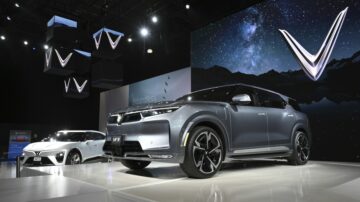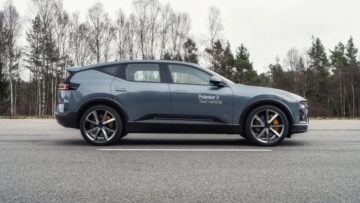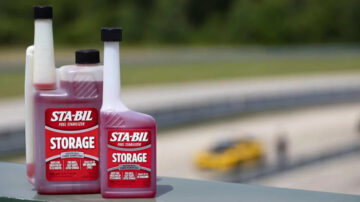Last week in our ongoing, difficult-to-name series, we gave our editors 48,000 fake dollars to buy something that could tow what was described as a “camper,” but in many countries, would be considered a small home. We, predictably, picked a bunch of ridiculous things technically capable of the task … but yeah, it might not go the best. Well, except Greg Rasa. He was smart and went with overkill.
This week, instead of buying something to tow a camper, we’re buying something to BE the camper. I’m only providing our editors with $28,000, because it’s just more interesting this way, and it seems a little more realistic given the third-car nature of most outdoor adventure rigs. If anything, this is still too generous.
Onto the rules!
- It can be new or used.
- It can NOT be an RV, be it a bus-style one or upfitted house-on-an-Econoline chassis sort of thing. That’s boring.
- You can spend every last cent on the vehicle OR leave in reserve however much it takes to transform the vehicle in question into a camper. In this event, please show your work ($$$) to some reasonable extent.
- You must sleep INSIDE this vehicle. You cannot buy a 911 and a roof tent. That’s a 911 with a roof tent, not a camper.
- I suppose it would be OK if there’s a way to get into the tent from the sunroof or something, thereby creating a contiguous structure as James May did in that one Top Gear episode (Jeremy Clarkson’s creation picture above was also from that).
Alright, let’s see what insane savvy choices we came up with!
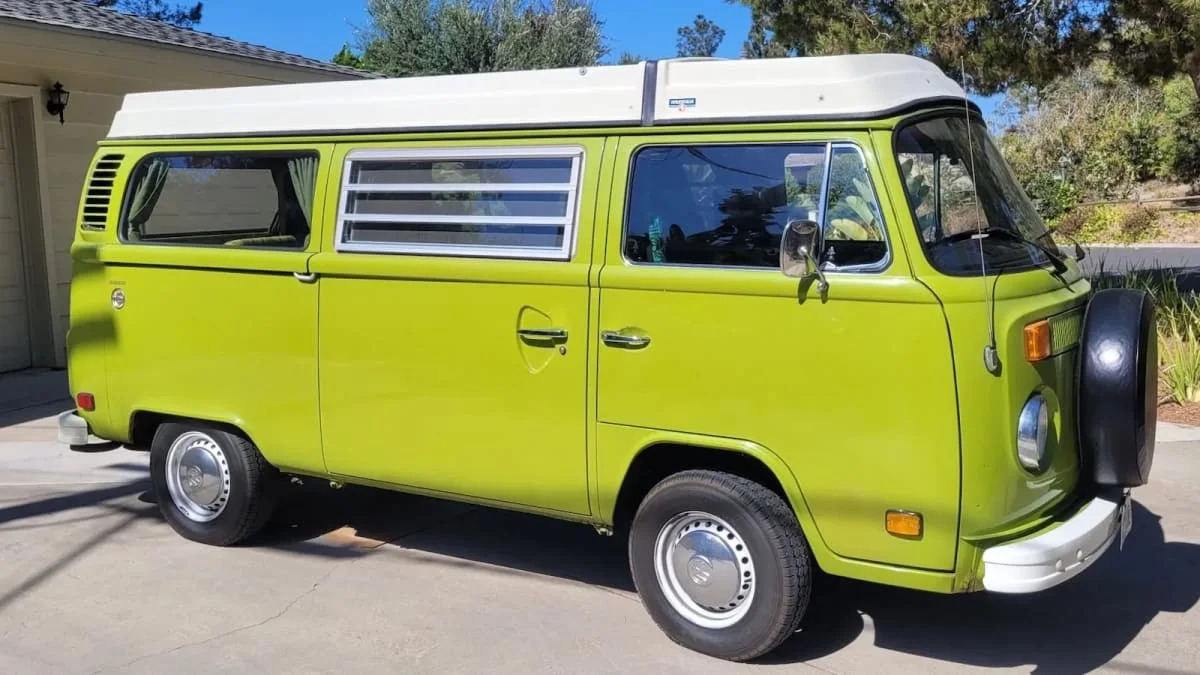
1979 Volkswagen camper van
Senior Editor Jeremy Korzeniewski: Shoutout to James for making this as easy as possible for me. I previously owned a VW camper van, a 1975 high-roof model in two-tone blue and white. I sold it to a great couple who used it to criss-cross the entirety of the United States, more than once I believe. Sometimes when we do these little virtual exercises, commenters love to tell us how dumb we are for what we picked. Like when I said I’d tow a family-size travel trailer with a Toyota Land Cruiser last week — kind of like how I towed my own 1975 VW van on a flatbed trailer along with various sundries from Washington State to Ohio a few years ago, weighing in at 6,000 pounds, with a Lexus GX 460 rated to tow a max of 6,500. With that in mind, would I buy, own, drive and camp in another VeeDub? Absolutely, without hesitation. I prefer the vintage air-cooled VW engines, partly because I like originality but more because I am very familiar with driving and working on them. I’ve never owned a wasserboxer, and I’m sure I’d be fine with it, but for the sake of this exercise I’ll stick with what I know.


I found this lovely 1979 Type 2 on Bring a Trailer, and it’s just right. It comes in at exactly $28,000 and is ready to go, complete with a fold-out bed in addition to the sleeping accommodations provided by the pop-up tent. There’s a sink, a stove, and a small refrigerator. No toilet, but there are forests all over the place. A porta potty would do in a pinch (ask me how I know). The green color is amazing, and the plaid interior is even better. Easy-peasy assignment this week. Thanks, James!

1996 Mazda Bongo Friendee
Senior Editor James Riswick: Here it is, the Mazda Bongo Friendee, ready as always to be a humorous addition to any list. However, rather than its usual inclusion on any “Craziest Car Name” listicle (I’ve written several), this time it gets to move beyond its delightfully bonkers moniker and showcase its actual talents. I mean, if a family of four can celebrate Christmas morning in this thing, complete with a Christmas tree, I’m pretty sure it’ll handle a simple camping trip. Just check out that seat versatility! Now, at 6-foot-3, do I have any confidence that I would be able to comfortably drive this thing, let alone sleep length-wise in the back? Oh heck no. But the upsides here seem substantial, including this particular Bongo Friendee’s incredible pale teal paint job, super ’90s graphics, 160-hp 2.5-liter V6, and the oddball delight of driving on the right side of the car. This will get people talking … especially after you say “I drive a Mazda Bongo Friendee” in all seriousness. The asking price from JDM Car & Motorcycle Auto Sales in Seattle is $21,995, which leaves plenty of money in the bank for an REI shopping spree and a sweet Christmas tree.
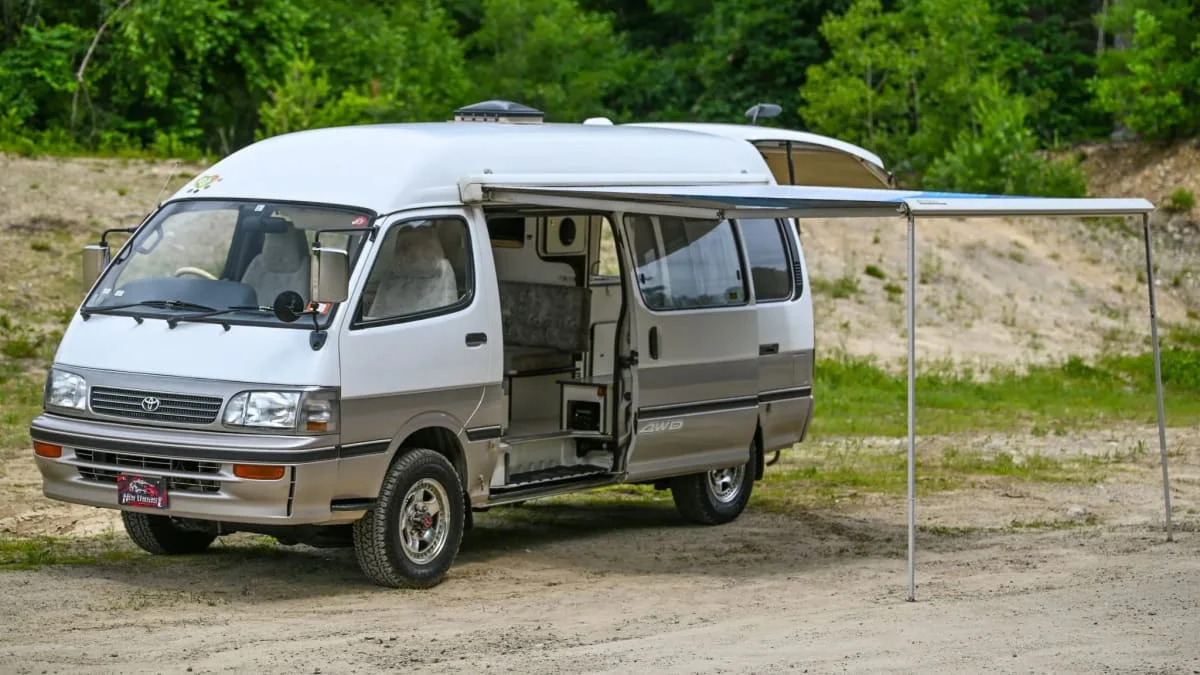
1995 Toyota HiAce Super GL 4WD Camper
Road Test Editor Zac Palmer: I was thinking of picking something ridiculous and inconvenient this week, but thought better of that and landed on this sweet HiAce Camper (Wait, you think a 28-year-old diesel-powered JDM van with the wheel on the right isn’t ridiculous or inconvenient?!? -JR) . I’ve loved these things since I saw someone trucking around in it on my college campus years ago, and to find one that’s fully set up for camping purposes is about as good as it gets for this task.
The HiAce is a van that is sure-footed when you take it off paved roads thanks to its four-wheel drive system and dual-range transfer case. Plus, get a load of that ground clearance! The diesel engine will be pricey to keep topped off, but at just around $15,000-$20,000, these vans don’t hurt the bank too bad from an initial purchase price perspective, and it’ll hopefully follow its reputation as a reliable Toyota product. A camper like this one comes with all the live-in niceties such as a stove, sink, refrigerator and toilet. Plus, the sleeping and hang-out spots are spacious in the tall and long van. When it comes to camping in moderate glamour – in a stylish and unique vehicle – I think it’s hard to beat the HiAce.



Ford F-250 and pop-up overland camper
Managing Editor Greg Rasa: First off … $28,000 will buy you 140 nights in $200 hotel rooms. Sure that’s a cheap room at today’s prices, but you’d have a soft, warm bed and a shower with plenty of hot water — and maybe a complimentary breakfast. Meanwhile, a camper van sounds cramped and icky. Some have toilets. Do you want to drive off to look at America hauling a stinky, sloshing tank of your own sewage?
This was a frustrating exercise, with Riswick’s rules saying you can’t just buy a trailer or RV. Which leaves camper vans as a primary area of exploration. But they’re obscenely expensive. Those Sprinter custom campers you see everywhere sell for well into triple digits, and even super-high-miles used ones are pricey. We have a lot of van upfitters here in the PNW, but you can’t even buy a decent donor van out of fleet service for $28 grand. We also get a lot of JDM import campers coming through the Northwest, but my colleagues went that route, I’m a big guy, and those rigs look snug. Bongo’s a no-go. Jeremy chose well; that VW will probably appreciate in value.
When the younger me car-camped, it was in a pickup with a cap. So, truck camper? Most of the slide-ins are super heavy – weighing a ton or more unladen — and have the aerodynamics of a concrete block; they’d surely be ponderous to drive. But what about this: I’ve recently had my eye on this nice-looking 1988 Ford F-250 in my area, seemingly well-kept with (supposedly) just 51,000 miles. Meanwhile, there’s a growing new segment of pop-up truck campers from companies like AT Overland, Go Fast Campers, OVRLND Campers and many more. These are spartan, but lightweight because they’re designed for backcountry adventures.
The two shown above are the Granby slide-in and the Project M topper from Four Wheel Campers. The Granby’s base price is $17,695, and it weighs just under 1,000 pounds. The Project M starts at $11,495 and weighs about 500 pounds (probably a bit more for the version that fits the F-250‘s 8-foot bed). The truck is advertised at $9,800, so either camper fits our budget, and the Project M leaves plenty of money to load it up with a nice awning and other factory options, of which there are a ton. And it’s available in a silver/gray that should complement the two-tone paint on that sweet old Ford.

1999 Chevy Suburban
Senior Editor John Beltz Snyder: When I got my driver’s license, I got a hand-me-down four-door Blazer from my sister. I loved that thing, and slept in it whenever I could. In fact, when I later replaced it with an XJ Cherokee, I lamented the few inches of length I lost that had allowed me to really stretch out in that Chevy. But my grandpa had a Suburban, and I always thought about how amazing that would be to camp in. So with this exercise, I can make my dream come true. With $28,000, there are a lot of options without a devastating amount of mileage. I’m going with this ’99 ‘Burban for $24,977. I like the green. I like the barn doors — maybe I can create some sort of swing-out cooking dealio or stuff-holder for them. With $3,000 left over, I’ve got a decent budget for building shelves and whatnot, wiring up some cool lighting, getting a comfortable mattress. There seem to be endless ideas for inspiration online. I don’t need anything fancy, just functional, roomy and able to get me off the beaten path a bit.


International Harvester Travelall
Associate Editor Byron Hurd: I’ve been looking for an excuse to drop the International Harvester Travelall into one of these challenges since we first started playing around with the format. Why? I can’t explain it. They’re quirky and I’ve got a borderline fetish for them. What more do you need to know?
IH Travelalls can be found in just about every condition and price range, but the late ’60s and early ’70s models are the ones I’m most keen on, and mechanically sound and solid examples seem to fetch mid-high teens to low 20s. As an added bonus, a car obtained for this purpose doesn’t need its full interior, so there’s no need to stretch the budget for clean back seats; they’re getting yanked anyway.
That leaves all the room in the back for improvised conveniences. Since the Travelall competed against the contemporary Suburban and Grand Wagoneer, the passenger and cargo area is pretty cavernous, so there’s plenty of room for up-fitting. The Travelall was based on IH’s half-ton pickup, so the electrical system should be up to the job of running some accessories. If not, the frame’s probably solid enough to anchor a wind turbine. Ready to crossover like it’s 1969? I am.
- SEO Powered Content & PR Distribution. Get Amplified Today.
- PlatoData.Network Vertical Generative Ai. Empower Yourself. Access Here.
- PlatoAiStream. Web3 Intelligence. Knowledge Amplified. Access Here.
- PlatoESG. Automotive / EVs, Carbon, CleanTech, Energy, Environment, Solar, Waste Management. Access Here.
- PlatoHealth. Biotech and Clinical Trials Intelligence. Access Here.
- ChartPrime. Elevate your Trading Game with ChartPrime. Access Here.
- BlockOffsets. Modernizing Environmental Offset Ownership. Access Here.
- Source: https://www.autoblog.com/2023/08/31/28k-camper/
- :is
- :not
- $3
- $UP
- 000
- 1
- 10
- 11
- 12
- 13
- 14
- 15%
- 16
- 17
- 19
- 20
- 22
- 23
- 24
- 25
- 26
- 27
- 28
- 29
- 30
- 500
- 51
- 7
- 8
- 9
- a
- Able
- About
- above
- absolutely
- accessories
- actual
- added
- addition
- Adventure
- After
- against
- ago
- All
- allowed
- alone
- along
- also
- always
- am
- amazing
- america
- amount
- an
- Anchor
- and
- Another
- any
- anything
- anyway
- appreciate
- ARE
- AREA
- around
- AS
- At
- auto
- available
- back
- Bad
- Bank
- base
- based
- BE
- because
- been
- believe
- BEST
- Better
- Beyond
- Big
- Bit
- Block
- Blue
- Bonus
- Boring
- Breakfast
- bring
- budget
- Building
- Bunch
- but
- buy
- Buying
- by
- came
- Camp
- camping
- Campus
- CAN
- cannot
- cap
- capable
- car
- Cargo
- case
- celebrate
- challenges
- chassis
- cheap
- check
- choices
- chose
- Christmas
- colleagues
- College
- come
- comes
- comfortable
- coming
- Companies
- competed
- Complement
- complete
- complimentary
- condition
- confidence
- considered
- contemporary
- cooking
- Cool
- could
- countries
- Couple
- create
- Creating
- creation
- custom
- delight
- described
- designed
- devastating
- DID
- diesel
- digits
- do
- doesn
- dollars
- don
- Dont
- doors
- dream
- drive
- driving
- Drop
- dumb
- Early
- easy
- editor
- either
- Elm
- Endless
- Engine
- Engines
- enough
- entirety
- episode
- especially
- Ether (ETH)
- Even
- Event
- Every
- exactly
- examples
- Except
- Exercise
- expensive
- Explain
- exploration
- extent
- eye
- fact
- factory
- fake
- familiar
- family
- FAST
- few
- Find
- fine
- First
- FLEET
- follow
- For
- Ford
- format
- found
- four
- FRAME
- from
- frustrating
- full
- fully
- functional
- gave
- get
- getting
- given
- glamour
- Go
- going
- good
- grand
- graphics
- great
- Green
- Ground
- Growing
- Guy
- had
- handle
- Hard
- Have
- he
- heavy
- here
- Home
- Hopefully
- HOT
- hotel
- How
- However
- HTML
- HTTPS
- Hurt
- i
- ideas
- if
- import
- in
- inches
- Including
- inclusion
- incredible
- initial
- inside
- Inspiration
- instead
- interesting
- interior
- International
- into
- IT
- ITS
- james
- Job
- John
- jpg
- just
- Keen
- Keep
- Kind
- Know
- Land
- Last
- Late
- later
- Leave
- left
- Length
- let
- License
- Lighting
- lightweight
- like
- List
- Listicle
- little
- ll
- load
- Long
- Look
- looking
- lost
- Lot
- love
- loved
- Low
- make
- Making
- many
- max
- May..
- maybe
- me
- mean
- Meanwhile
- might
- mind
- models
- moderate
- money
- more
- morning
- most
- motorcycle
- move
- much
- must
- my
- name
- Nature
- Need
- never
- New
- nice
- no
- now
- obtained
- of
- off
- oh
- Ohio
- Old
- on
- once
- ONE
- ones
- ongoing
- online
- only
- Options
- or
- originality
- Other
- our
- out
- Outdoor
- over
- own
- owned
- paint
- Palmer
- particular
- path
- paved
- People
- perspective
- picked
- Pickup
- picture
- Place
- PLAID
- plato
- Plato Data Intelligence
- PlatoData
- playing
- please
- Plenty
- plus
- pop-up
- PoS
- possible
- pounds
- prefer
- pretty
- previously
- price
- Prices
- primary
- probably
- Product
- project
- provided
- providing
- purchase
- purpose
- purposes
- question
- range
- rasa
- rated
- rather
- RE
- ready
- realistic
- really
- reasonable
- recently
- reliable
- replaced
- reputation
- Reserve
- right
- roads
- roof
- Room
- Rooms
- Route
- rules
- running
- s
- Said
- sake
- sales
- savvy
- saw
- say
- saying
- Seattle
- SEC
- see
- seem
- seemingly
- seems
- segment
- sell
- service
- set
- several
- shelves
- Shopping
- should
- show
- showcase
- shown
- side
- Simple
- since
- sister
- sleep
- small
- smart
- So
- Soft
- sold
- solid
- some
- Someone
- something
- Sound
- Spartan
- spend
- spots
- started
- starts
- State
- States
- Stick
- Still
- structure
- substantial
- such
- Super
- sure
- surely
- sweet
- system
- T
- Take
- takes
- talents
- talking
- tank
- Task
- TEAL
- technically
- Teens
- tell
- tent
- test
- than
- thanks
- that
- The
- Them
- There.
- thereby
- These
- they
- thing
- things
- Think
- Thinking
- this
- this week
- those
- thought
- Through
- time
- to
- today’s
- Toilet
- Ton
- too
- topped
- toyota
- trailer
- transfer
- Transform
- travel
- tree
- trip
- Triple
- truck
- Trucking
- true
- turbine
- two
- type
- under
- underline
- unique
- United
- United States
- us
- used
- value
- various
- Ve
- vehicle
- version
- very
- vintage
- Virtual
- volkswagen
- vw
- wait
- want
- warm
- was
- washington
- washington state
- Water
- Way..
- we
- week
- weighing
- weighs
- WELL
- went
- What
- Wheel
- when
- whenever
- which
- white
- WHO
- why
- Wikipedia
- will
- wind
- wind turbine
- with
- without
- Work
- working
- would
- written
- Yahoo
- years
- you
- Younger
- Your
- zephyrnet





